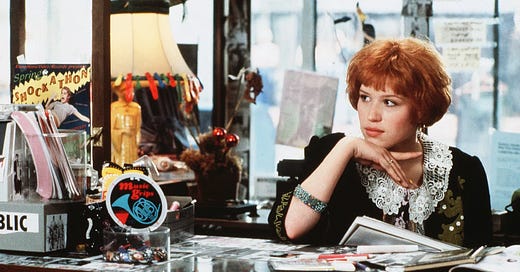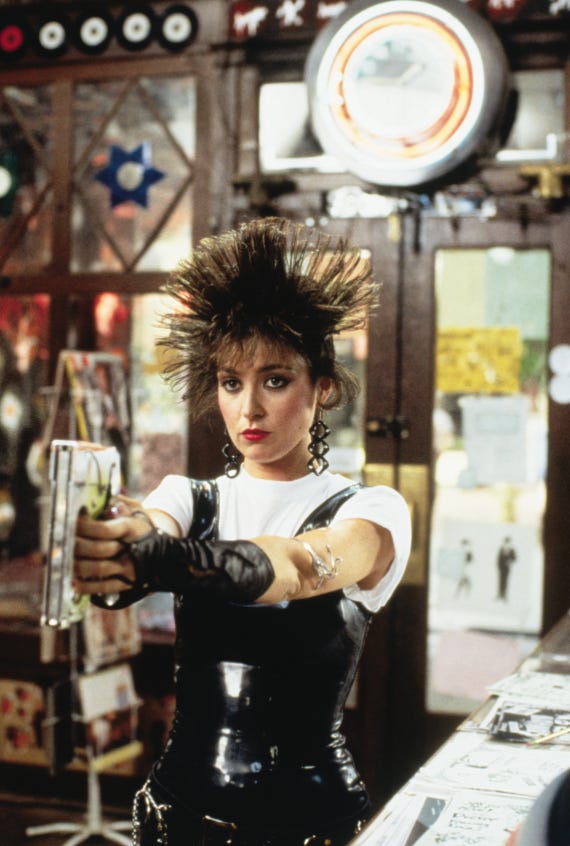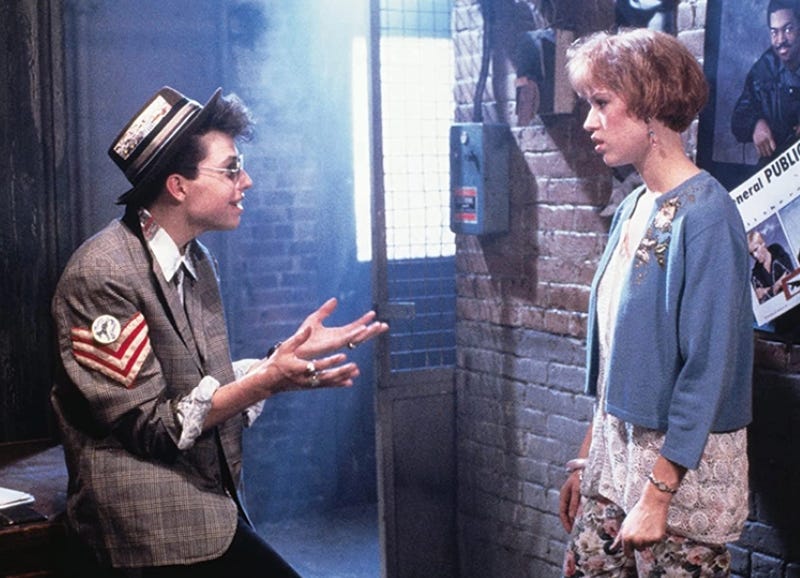Left of Center
"10 Movies, 10 Stories of Whiteness" Issue Four: Pretty and Pink and what you learn (about race, class, queerness and more) in the suburbs
Top notes (from Garrett):
Seriously you all, I’m so excited for this week’s guest essay (a White Pages first!). This piece is written by Susannah Bartlow, whose full bio is down below and who is currently offering some really exciting upcoming workshops through We Are Finding Freedom- check out that hyperlink). I love Susannah’s piece for many reasons, (the way she weaves her own bio so seamlessly into a deep analysis of the Molly Ringwald classic, the great explainer on the 2-Tone movement, the fun she has with queer readings, etc. etc. etc.). Most of all, though, I think it’s a really powerful model for how to look back at a piece of art that helped shape your life with both a loving, nostalgic heart and and a critical eye at the same time.
It’s a gift to get to publish Susannah’s work (and to be able to compensate her for her time and wisdom). To celebrate this fun, new moment for The White Pages (and to help ensure that I can pay future contributors as well- we’ve got some terrific ones lined up), what say we have a one week subscription sale? Cool? Cool!
Oh, and if you’re new here and you’re not sure what this whole “movie series” is about, you can find an explainer here and all of the previous entries here.
I don’t remember the first time I saw Pretty in Pink–it feels like it was just a part of the preteen package in 1989, the year my family moved from Philly to Reading, Pennsylvania. The move was tough. When I finally made friends (with the other new kids), we would have sleepovers and raid the VHS and cassette tape collections of their cool older siblings. That’s how I first met Pretty in Pink’s self-possessed, creative, and lonely heroine, Andie Walsh; and first heard Suzanne Vega’s “Left of Center”.
I think that somehow
Somewhere inside of us
We must be similar
If not the same
So I continue to be wanting you
Left of center, against the grain
So many 80s movies are stories about isolation and belonging, but Pretty in Pink was one of a trifecta of teen movies (along with Heathers and Pump Up the Volume) that met my voracious need in what felt like a very personal way. I longed to be smooth like Joe Jackson’s piano; tender, clear and careful as Suzanne Vega's voice. Instead of dodging bullies, boredom, and inchoate longing, I found in these films seeds of a queer survival strategy that would serve me for many years: find a safe pocket left of center and do my thing until I get out.
And if you want me
You can find me left of center
Wondering about you
It wasn’t until many years later that I understood how privileged this protected ground truly was–a privilege that Pretty in Pink mirrors for every one of its characters. I’m interested in what’s different about this movie and what it can teach white queers and others about how our oppositional identities can be both liberatory and dominating. Whiteness, in a violent failure of imagination, makes itself the whole world, even (especially) when it’s a world that is lonely, disappointing and cruel. Pretty in Pink, in turn, imagines a universe where working-class people and people who go “against the grain” can be happy – as long as everyone is white.
**
When we moved, I had just finished my first year of middle school –I rode the bus to a large, diverse school in a suburban district less than a mile from Philadelphia County. In Reading, I walked the quarter-mile to junior high with a group of neighborhood girls, including one of the only Jewish kids in our school. Each morning, we met up at her house and a few boys would follow us and say hateful things to her as we walked the quarter-mile in a protective circle. Kids and adults would make racist and classist comments about Mexican agricultural workers and the “white trash” working-class people who lived in the city (or who got bused up the hill on the other side of the tracks from the school). Our post WWII split-level house was owned by the church my mother pastored, and many of the parishioners commented on how much better it was that the church bought a house in the suburbs, where it was “safe”.
Whiteness lesson one: whiteness is ever-present and never named. The racism in my new hometown was always about using a large group identity to cast people as scary “others”. In hindsight it’s glaring, but at the time, I didn’t know that all these comments and choices were not only about people of color–they were also creating my understanding of white group identity in the suburbs. My parents encouraged racial justice and the vision of the world advanced by liberal and leftist Christians. My mom, a Methodist pastor, did gay marriages on the sly and taught us about abortion rights. No doubt we were problematic in our own white liberal way (that’s a different essay). But it was harsh to land at a school where the student mock election was a landslide for George H.W. Bush, and people my age said the kinds of things I’d only heard in caricatures of racists on tv. I didn’t belong and I didn’t want to.
At the same time, in that standard junior high way, belonging is all I wanted. Whiteness lesson two: collusion is a survival strategy. When the other girls carried their swimsuits home in plastic Gap bags, I begged to go to the Gap for weeks (we were mostly a Boscov’s and Kmart family). Eventually, I found a pair of boxers on clearance that my mom agreed to buy (and had to ask the salesperson to put it in the bigger bag so I could get what I came for). But as a dorky queer kid, no matter what I did, I couldn’t fit in.
After a few years of trying, I began creating an oppositional identity. I merged with the other outsiders–kids who later came out, theater nerds, people who didn’t grow up there, children of divorced parents–and became the sarcastic one, the know-it-all, and the scornful older sister. This was the heyday of early indie labels and the emergence of alternative music as a genre. I voraciously consumed Sassy magazine, got knockoff Docs at the mall, and spent hours with my door closed hovered over my stereo, recording everything I could off the college radio station.
Helping me sculpt this new identity was the tender, hopeful, and bittersweet story and music of Pretty in Pink. Andie’s world–with its strict social hierarchies, creative interests, and profound loneliness–affirmed my experience while offering an aspirational fairy tale. Pretty in Pink pulls together class struggle, punk and underground music, yuppie alienation, sexual harassment and heterosexism, fathers and daughters into a narrative that offers both a deeply conservative individualism and a radical affirmation of punk and queer subcultures. The film is nominally set in Elgin, IL, but its heart and home is an imaginary Chicago where oddball white people can play and live in subcultural safety–the epitome of this is Iona, Andie’s big sister/mother figure who runs the legendary Wax Trax record store. The store, a club called Cats, and Iona’s Chinatown apartment are (along with Andie’s house) warmly lit and full of energy. In the first club scene, 2-Tone house band the Rave Ups (in reality an all-white Americana band from Pittsburgh) set the tone for Andie’s city life with a white singer and an all-Black band playing ska music.
The racial makeup of the band cashes in on the credibility of 2-Tone as a movement as much as a musical style. 2-Tone emerged from the cultural and political solidarity between Black and white working-class British youth in the late 70s and early 80s. In its heyday, ska and 2-Tone led Rock Against Racism cultural organizing in the UK and were part of a wider resistance movement including anti-racist punk rock in the U.S. (like Minnesota’s The Baldies). Pretty in Pink gestures at 2-Tone through the club scenes and Duckie’s style and persona, but it’s more set dressing– even Andie’s city world is all-encompassingly white, and the politics at the core of the movie reinforce individual agency (not collective struggle) as the key to overcoming social stratification. Whiteness lesson three: it’s all up for grabs and if it looks good, that’s good enough.
Even where other films might offer up a B-plot interracial romance (like the original Hairspray), or a bit character who adds some color to the film (in a grimly racist, literal sense), Pretty in Pink uses the city as a shorthand to legitimize the coolness and the otherness of its white characters. Most of the shoppers in Iona’s store are white, as are the very few extras we see in a small number of street/background scenes. The club itself is full of white punks, but has graffiti and a smoker outside – gestures at Black identity and urban life that are scarce but show up in the background at key moments. It’s an odd juxtaposition that mostly uses set design and music to signal proximity to people of color while erasing people of color characters–whether marginal or fully realized–entirely.
The pinnacle of this racial narrative is a brief moment between Duckie and a man in Chinatown, who smiles at him with a deeply stereotypical expression. It’s the longest interaction between a white person and a person of color in the entire film, and it’s a 5-second cutaway from a sweet and intimate conversation between Andie and Iona about the prom. The editing is so clunky, and the interaction so brief and odd–not played for laughs or fear, without dialogue–that it’s baffling. It obviously calls up the overtly racist anti-Asian bias in other Hughes movies. The man he interacts with isn’t treated as a man–he’s a kind of set dressing, there to show Duckie’s loyalty and awkwardness, and to reinforce the otherness of where Iona lives. When Iona starts dating a nice yuppie, she trades her punk/thrift store style for a blazer and pearls, declaring that she'll probably end up “picking out china patterns soon”. The next step in the gentrifier progression will be for Iona to give Andie her funky Chinatown apartment and move back to the suburbs.
The message is: somewhere out there–beyond Elgin and the white halls of the high school–is a more interesting world, somewhere that misfits and working-class kids can find connection and community against a backdrop of people of color who are there for laughs, contrast or entertainment.
At the same time that Pretty In Pink creates a totalizing whiteness, it offers delightful and clear-cut skewering of the differences between wealthy WASP culture and white working class life. The working class characters lead rich lives full of culture, music and community. They are subjected to bullying or disadvantages but mostly take those in stride or are honest about them. They connect with one another in ways that are about fun, support, pleasure, making art, or being emotionally close. When they fight, it’s quick, honest, and solvable–no one is disposable. Not only is Andie the movie’s moral center, but her world just looks more fun.
By contrast, people with money live in highly regulated networks where they monitor each other’s behavior for allegiance to the explicit but unwritten caste rules. They never have to worry about resources; they project confidence but are internally grasping and insecure. Their casual conversations are insincere, cruel, or cutting, and their body language is tense and uncertain. One of the film’s primary tensions is whether Blane and Andie’s friends will overcome their class resentments and welcome the new relationship. Andie’s friends mostly come around, but Blane has to sever his ties, and doing so is also the ultimate act of self-actualization–in the climactic prom scene, he tells Andie, “You believed in me. I didn’t believe in myself.” To his friends, Blane is disposable; to connect with Andie, he has to learn how not to give up on himself–but then, all he has is Andie. Whiteness lesson four: heteronormativity and the romance myth can take the place of a healthy community.
**
Listen, I know this is fundamentally a teen romantic comedy, don’t get me wrong. But these fantasies are where our cultures get made. Pretty in Pink displays many core traits of whiteness identified by critical race scholars–white Americans want to engage Black culture and other forms of cultural difference without caring about or knowing people of color; white identity is fundamentally about reinforcing social hierarchy through violence and exclusion. At the same time, I’ve been happily singing along with the soundtrack and relishing the class critiques and Andie’s autonomy, wondering – what did it mean for my 12-year-old self, and what does it mean to me now, that both/all of these things are true? These are the contradictions we have to reckon with as white people practicing a commitment to racial justice.
Pretty in Pink was a touchstone for me– it inspired my creative self, encouraged independent thinking, and gave me context for a bigger world beyond the suburbs when I felt the most discouraged by my surroundings. At the same time–just like so much of the college radio, punk, and alternative worlds I poured into for longer than I should have – the movie is glaringly white, racist, and sexist. Re-examining this world along with, for example, riot grrl, white feminism, and the other touchstones of my early years, I’m grateful for what it gave me. I’m also hungry for narratives that could have done better–pushed me farther faster, or met my needs in ways that didn’t reify middle-class white womanhood. I don’t feel regret, exactly–just loss. If I had been a little more kind and less defensive with the people I loved or sat next to in class; if I had set different boundaries in the Duckie-like dynamic in my own life–what kinds of relationships, art, career choices, financial decisions might I now be making? What did we gain, and what did we lose, in moments we dropped into our privilege instead of finding our collective power? Where are we right now, today, escaping into our comforts and privileges, and how can we use a radical imagination to do something else?
As white people, we have so much unearned power and such limited imaginations. What's lost when stories about the numbing suburbs are as confined as the suburbs themselves? While I was writing this, I started to imagine alternative versions of this movie that create solidarity. I started speculating about what the movie would be like if Duckie was a queer Black guy, or if Andie was a Latina goth girl. I entertained myself by outlining a queer counter-reading/fanfic of this story: Steff is gay for Blane, Benny is into Andie but doesn’t know how to admit it, Iona and Jena had a secret thing one night after the bar but agreed it was a fling, Blane is a soft butch looking to be spoiled by a high femme he can worship, and Andie is super queer high femme top who wants someone to take care of her like she takes care of her dad. How can we sink deeper into those possibilities–imagining the worlds we wish we could create, creating them together?
I can’t go back and make John Hughes films not racist, erase racial covenants, make gentrification make sense, or make me a braver teenager less constrained by the hurt of not belonging. But reading left of center, we can look to where the texts and songs we love offer a glimmer of possibility, reject what we know is cruel, and push for collective liberation in ways we are just beginning to imagine.
Susannah Bartlow is a writer, auntie, facilitator, and project manager based on Dakota land (Minneapolis). She’s published work reckoning with the legacies of white feminism since 2008. In 2015, she was fired for supporting a campus student mural of Assata Shakur--she now works in health outreach and equity and facilitates workshops and strategies for Finding Freedom, a collective of white women resisting white supremacy (www.wearefindingfreedom.org). In addition to being a recovering academic, she's also a recovering indie snob.
End Notes (from Garrett):
See what I mean? What a great essay! If you enjoyed it as much as I did, definitely show some love in the comments (and also check out Susannah’s upcoming workshops).
As for the song of the week, reading this essay also inspired me to go back to the Pretty In Pink soundtrack, which is just packed with anthems for outcasts (both suburban and otherwise). Where can you find Suzanne Vega? You already know the answer.
Also, I’ve been lax in updating the Songs of the Week Playlist, but I think I’ve finally caught up. Enjoy! On Apple Music or Spotify!








I loved this so much!! This film came out the summer between my freshman and sophomore years of high school, just when I was making friends and forming groups with the outcasts and carving my own “alternative” identity. This brought so much back to me. It’s been so many years since I’ve seen it, so I will have to give it a rewatch.
I love your rewrite ideas. Seriously, having lived during this time and dated so many boys that were just like Duckie (very purposefully) - they ALL ended up coming out of the closet after high school. There is no way Duckie was ever straight. But, during that time, you just didn’t come out. Such a different time.
This film is so beyond white - as I agree all of Huges’ films are. I have never looked or thought about any of them critically because they were such the anthem of my youth! After the mention of anti-Asian themes, I thought of the humor relief Long Duck Dong’s “stereotypical” character was in Sixteen Candles.
Thank you so much for this!
this is such a wonderful, delightful, and insightful essay! i really love the way you point out the way that class plays out in the movie through body language and styles of conflict.
also it's truly impossible for me to see the movie without reading duckie as queer-- the moping around to the smiths, mooning over someone unattainable!